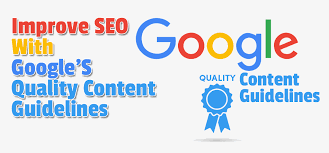In the ever-evolving landscape of search engine optimization (SEO), staying informed about Google’s content guidelines is crucial for anyone looking to improve their website’s visibility and ranking. Google continuously updates its algorithms to provide users with the most relevant, high-quality content possible. As such, understanding and adhering to these guidelines is key to crafting content that not only resonates with your audience but also aligns with Google’s standards, ensuring your site remains in good standing. Here’s what you need to know about Google’s content guidelines as of 2023.
The Pillars of Google’s Content Guidelines
1. E-A-T: Expertise, Authoritativeness, Trustworthiness
One of the core principles underpinning Google’s content evaluation is E-A-T. This framework assesses the expertise of the content creator, the authoritativeness of the website and content, and the trustworthiness of both. Google emphasizes the importance of E-A-T, especially for Your Money or Your Life (YMYL) pages, which could potentially impact a person’s future happiness, health, financial stability, or safety. Ensuring that content is created by knowledgeable authors and backed by reputable sources is crucial.
2. Beneficial Purpose
Every page on your website should have a clear and beneficial purpose to the user. Google prioritizes content that is created to help, inform, entertain, or serve users in some meaningful way. Pages designed primarily to manipulate search rankings rather than provide genuine value to readers may be penalized.
3. Quality Content
Quality is paramount when it comes to content. Google’s guidelines encourage original, thorough, and well-researched content. This includes ensuring accuracy, covering topics comprehensively, and providing unique insights. High-quality content should meet the needs of users, directly answering their queries with actionable and useful information.
4. User Experience (UX)
Google’s algorithms also consider the overall user experience of a website, including its design, navigation, and mobile-friendliness. Sites that are easy to use, navigate, and read on various devices are more likely to rank favorably. Loading speed, interactivity, and visual stability are also part of Google’s Core Web Vitals, which play a role in determining a site’s ranking.
5. Avoiding Manipulative Practices
Google’s guidelines strictly prohibit manipulative practices designed to game the system. This includes keyword stuffing, cloaking, and using private link networks. Such practices can lead to penalties, significantly impacting your site’s visibility in search results. Google encourages webmasters to focus on creating valuable content for users rather than trying to outsmart search algorithms.
Implementing Google’s Guidelines: Best Practices
- Regularly Review and Update Content: Keep your content up-to-date and relevant to maintain its usefulness for readers.
- Enhance E-A-T: Highlight the expertise of your content creators and ensure that all information is accurate and sourced from authoritative sites.
- Focus on User Intent: Understand what users are looking for when they enter a query and tailor your content to meet those needs directly and efficiently.
- Improve Site UX: Ensure your website is responsive, loads quickly, and provides a seamless user experience across all devices.
- Engage in Ethical SEO: Follow white-hat SEO practices that focus on creating value for users rather than attempting to manipulate rankings.
Conclusion
Google’s content guidelines are designed to ensure that users are presented with the most relevant, useful, and high-quality content. By adhering to these guidelines, content creators and website owners can improve their SEO performance, enhance user engagement, and achieve better search rankings. Remember, SEO is a long-term strategy that benefits most from a commitment to quality, relevance, and user satisfaction. Stay informed about the latest updates from Google and continually adapt your content strategy to align with these best practices for sustained success.

